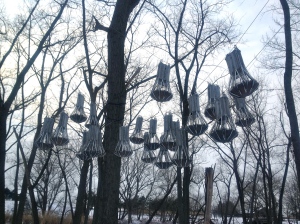The Bridge to Nature
Contrary to popular generalization, architecture is not only for people.
Through ages of development, advancement and industrialization, the gap between man and nature has exponentially increased. There is a disconnect between the two that is created by the constructions of barriers and walls. While architecture is initially seen as a factor that creates this gap, architecture can also be seen as a tool to reconnect.
This week, our group saw two architectural pieces that have attempted to reconnect to nature. While one takes a more passive stance, the other actively and bravely engage itself in nature.
The first project was an animal architecture project done by one of our professors Joyce Hwang. The project is called Bat Cloud and it is located in Tifft Nature Preserve. This project is a reaction to the decline of bat population and the designed product is to support bat inhabitation.
For more info on Bat Cloud, visit Joyce Hwang’s Page.

The next location was at Erie Basin Marina where there are many structures and points of observation. The main attraction of viewing is the 1970s brutalist construction of the observation tower by DiDonato Renaldo Associates. This tower allows visitors to not only view the city, but also mainly focused at providing a grand view of the erie basin. The visitor is able to turn their backs on the city and be absorbed into the magnificence of the seemingly endless waterfront.
Should we take on a more active role in interacting with nature, or is it better to leave it be? Is it ethically right to watch the erosion of nature, when it is also human who has carried out this act of destruction? Or is creating architecture to interact with nature too prescriptive and controlling?
